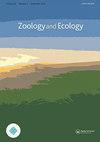Characterization and diversity of macroinvertebrates of the Bouhamdane Stream (northeast of Algeria)
Q4 Environmental Science
引用次数: 2
Abstract
Freshwaters are among the most threatened ecosystems, particularly in North Africa where urbanization and climate change are exerting an important pressure on aquatic fauna. Long-term investigation of macroinvertebrates is one of the best ways of tracking and understanding the influence of environmental and anthropogenic pressures on community dynamics. In this study, we focus on determining the community structure and diversity of benthic macroinvertebrates as well as the state of aquatic physicochemical parameters in the Bouhamdane Stream, near the outlet of Bouhamdane dam, Seybouse watershed, north-eastern Algeria. We carried out a bi-monthly sampling of macroinvertebrates and nine water physicochemical parameters from September 2017 to July 2018 at three sites. Results show that the collected macroinvertebrates (6756 individuals) belong to 15 families and 12 orders. The abundance of the macrofauna consisted of 88.19% crustaceans, 7.74% insects, 3.7% molluscs and 0.16% annelids. Physicochemical analyzes (depth, turbidity, pH, dissolved O2, temperature, salinity, and conductivity) showed variability among sites. The families of Gammaridae and Baetidae were the most frequent and the most abundant on all the stations. The results indicate that aquatic macroinvertebrates constitute good indicators of the biological quality of water. This study shows that even with the occurrence of regular dam water discharge, the macroinvertebrate community is still able to persist either through adaptation to high water velocity or high colonization rate.阿尔及利亚东北部Bouhamdane溪流大型无脊椎动物的特征和多样性
淡水是最受威胁的生态系统之一,尤其是在北非,那里的城市化和气候变化正在对水生动物施加重要压力。对大型无脊椎动物的长期调查是追踪和了解环境和人为压力对群落动态影响的最佳方法之一。在这项研究中,我们重点确定了阿尔及利亚东北部Seybouse流域Bouhamdane大坝出口附近的Bouhamdana溪流中底栖大型无脊椎动物的群落结构和多样性,以及水生理化参数的状态。2017年9月至2018年7月,我们在三个地点对大型无脊椎动物和九个水物理化学参数进行了两个月的采样。结果表明,采集到的大型无脊椎动物(6756只)分属12目15科。大型动物群的丰度包括88.19%的甲壳类动物、7.74%的昆虫、3.7%的软体动物和0.16%的环节动物。物理化学分析(深度、浊度、pH、溶解O2、温度、盐度和电导率)显示了不同地点之间的可变性。在所有站点中,斑蝶科和斑蝶科的出现频率最高,数量最多。结果表明,水生大型无脊椎动物是水体生物质量的良好指标。这项研究表明,即使大坝定期排水,大型无脊椎动物群落仍然能够通过适应高水流速度或高定植率而持续存在。
本文章由计算机程序翻译,如有差异,请以英文原文为准。
求助全文
约1分钟内获得全文
求助全文
来源期刊

Zoology and Ecology
Agricultural and Biological Sciences-Animal Science and Zoology
CiteScore
1.00
自引率
0.00%
发文量
1
 求助内容:
求助内容: 应助结果提醒方式:
应助结果提醒方式:


